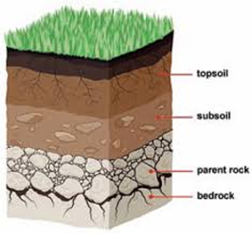We’re a selfie-obsessed and a photogenic generation. Today everything and anything has a profile somewhere or the other. Do you know even soil has one? Don’t believe us? Look for yourself. Scroll to see ‘Soil Profile’.
Suggested Videos
Formation of Soil
The soil has taken thousands of years to form. Soil formation takes place in the following ways:
- Big rocks break down into smaller rocks by continuous action of wind and rain. It takes many years for these rocks to break down into smaller rocks.
- Rocks are mainly broken by two types of weathering- physical weathering and chemical weathering. A number of natural force, called agents, work to break down the parent rock into tiny particles of soil. These agents include wind, water, the sun’s heat, and plants and animals.
- These pieces get further broken down to form sand and silt and, ultimately, into finer particles and the process continues. This process is very slow. It takes thousands of years to form a just 1cm layer of soil. These fine particles form the top layer of the soil.
Browse more Topics under Soil
What are the causes of Thunderstorms and Cyclones?
Soil Profile
The soil is found in layers, which are arranged during the formation of soil. These layers called horizons, the sequence of layers is the soil profile. The layers of soil can easily be observed by their color and size of particles. The main layers of the soil are topsoil, subsoil and the parent rock. Each layer has its own characteristics.
These features of the layer of soil play a very important role in determining the use of the soil. Soil that has developed three layers, is mature soil. It takes many years under a favorable condition for the soil to develop its three layers. At some places, the soil contains only two layers. Such soil is immature soil.
Horizons of the Soil
Soil consists of the following horizons:
1. Horizon A or Topsoil
It is also called the humus layer, which is rich in organic material. This layer consists of decomposed material and organic matter. This is the reason, the topsoil has a dark brown color. The hummus makes the topsoil soft, porous to hold enough air and water. In this layer, the seeds germinate and roots of the plants grow. Many living organisms like earthworms, millipedes, and centipedes, bacteria, and fungi are found in this layer of soil.
What are the different Properties of Soil?
2. Horizon B or Subsoil
Just below the topsoil lies another layer called subsoil or horizon-B. It is comparatively harder and compact than topsoil. It is lighter in color than the topsoil because there is less humus in this layer. This layer is less organic but is rich in minerals brought down from the topsoil. It contains metal salts, especially iron oxide in a large proportion. Farmers often mix horizon-A and horizon-B when ploughing their fields.
3. Bedrock or Horizon C
Bedrock is also known as parent rock and lies just below the subsoil. It contains no organic matter and made up of stones and rocks, so it is very hard. This layer represents a transition zone between the earth’s bedrock and horizon A and B.

Question For You
Q. What is humus layer in the soil?
Ans: It is also called topsoil or horizon A, which is rich in organic material.This layer consists of decomposed material and organic matter. This is the reason, the topsoil has dark brown color. The humus makes the topsoil soft, porous to hold enough air and water. In this layer, the seeds germinate and roots of the plants grow. Many living organisms like earthworms, millipedes, and centipedes, bacteria, and fungi are found in this layer of soil.







Which type of soil is used crop paddy
clayey soil
Clayey soil.. Is usually used for paddy crop..
Sandy loam soil
Can I know the list of soils suitable for AGRI and Horti crops? In detail for each crop!
i heard cotton grows well in sandy loam which drains water easily but i also heard that it grows well in black soil which retains water. please tell me which is correct.
Black soil
Cotton can due well in sandy loam soil well drain and not water logging area.
This app is free or what
Which type of soil is used to grow spices
i dont know
How can we use different types of soil in farming?
you dont know
how can we use different types of soil in farming
yes how.